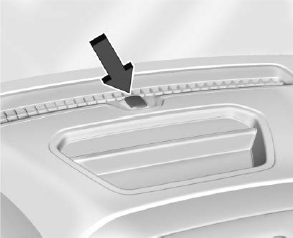Chevrolet Silverado: Wheels and Tires / Tire Pressure
Tires need the correct amount of air pressure to operate effectively.
Warning
Neither tire underinflation nor overinflation is good. Underinflated tires, or tires that do not have enough air, can result in:
- Tire overloading and overheating, which could lead to a blowout.
- Premature or irregular wear.
- Poor handling.
- Reduced fuel economy.
Overinflated tires, or tires that have too much air, can result in:
- Unusual wear.
- Poor handling.
- Rough ride.
- Needless damage from road hazards.
The Tire and Loading Information label on the vehicle indicates the original equipment tires and the correct cold tire inflation pressures. The recommended pressure is the minimum air pressure needed to support the vehicle's maximum load carrying capacity.
For additional information regarding how much weight the vehicle can carry, and an example of the Tire and Loading Information label, see Vehicle Load Limits. How the vehicle is loaded affects vehicle handling and ride comfort. Never load the vehicle with more weight than it was designed to carry.
When to Check
Check the pressure of the tires once a month or more.
Do not forget the spare tire, if the vehicle has one. See Full-Size Spare Tire for additional information.
How to Check
Use a good quality pocket-type gauge to check tire pressure. Proper tire inflation cannot be determined by looking at the tire. Check the tire inflation pressure when the tires are cold, meaning the vehicle has not been driven for at least three hours or no more than 1.6 km (1 mi).
Remove the valve cap from the tire valve stem. Press the tire gauge firmly onto the valve to get a pressure measurement. If the cold tire inflation pressure matches the recommended pressure on the Tire and Loading Information label, no further adjustment is necessary. If the inflation pressure is low, add air until the recommended pressure is reached. If the inflation pressure is high, press on the metal stem in the center of the tire valve to release air.
Re-check the tire pressure with the tire gauge.
Put the valve caps back on the valve stems to keep out dirt and moisture and prevent leaks. Use only valve caps designed for the vehicle by GM. TPMS sensors could be damaged and would not be covered by the vehicle warranty.
 Tire Terminology and Definitions
Tire Terminology and Definitions
Air Pressure : The amount of air inside the tire pressing outward on each
square inch of the tire. Air pressure is expressed in kPa (kilopascal) or psi (pounds
per square inch)...
 Tire Pressure for High-Speed Operation
Tire Pressure for High-Speed Operation
Warning
Driving at high speeds, 160 km/h (100 mph) or higher, puts additional strain
on tires. Sustained high-speed driving causes excessive heat buildup and can cause
sudden tire failure...
Other information:
Chevrolet Silverado 2019-2025 Owners Manual: Vehicle Data Recording and Privacy
The vehicle has a number of computers that record information about the vehicle’s performance and how it is driven or used. For example, the vehicle uses computer modules to monitor and control engine and transmission performance, to monitor the conditions for airbag deployment and deploy them in a crash, and, if equipped, to provide antilock braking to help the driver control the vehicle...
Chevrolet Silverado 2019-2025 Owners Manual: Horn, Windshield Wiper/Washe
To sound the horn, press on the steering wheel. Windshield Wiper/Washer The windshield wiper control is on the turn signal lever. The windshield wipers are controlled by turning the band with on it. With the ignition on or in ACC/ACCESSORY, turn the band to select the wiper speed...
Categories
- Manuals Home
- 4th Generation Silverado Owners Manual
- 4th Generation Silverado Service Manual
- Folding Mirrors
- Instrument Panel Fuse Block (Right)
- Steering Column Lock
- New on site
- Most important about car
Vehicle Alarm System

The indicator light, on the instrument panel near the windshield, indicates the status of the system.
